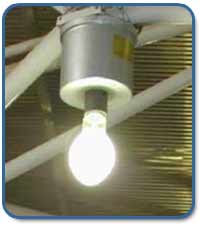High-intensity discharge (HID) lamps are similar to fluorescents in that an arc is generated between two electrodes. The arc in an HID source is shorter, yet it generates much more light, heat, and pressure within the arc tube.
Below are HID sources, listed in increasing order of efficacy (lumens per watt):
- mercury vapor
- metal halide
- high-pressure sodium
- low-pressure sodium
Like fluorescent lights, HID also requires ballasts, and they take a few seconds to produce light when first turned on because the ballast needs time to establish the electric arc.

| Advantages of HID lamps | Disadvantages of HID lamps |
|---|---|
|
|

Types of High-Intensity Discharge Lamps
Mercury vapor lamps
Mercury vapor lamps are widely used to light both indoor and outdoor areas such as gymnasiums, factories, department stores, banks, highways, parks, and sports fields.
Mercury vapor lamps consist of an inner arc discharge tube constructed of quartz surrounded by an outer hard borosilicate glass envelope. Shortwave UV, a result of the decay of mercury atom electrons from an excited to a stable state, is readily transmitted through the inner quartz tube but is virtually blocked by the outer glass envelope during normal operation.
Metal Halide lamps
Metal Halide lamps are similar to mercury vapor lamps but use metal halide additives inside the arc tube along with the mercury and argon. These additives enable the lamp to produce more visible light per watt with improved color rendition.
Wattages range from 32 to 2,000, offering a wide range of indoor and outdoor applications. The efficacy of metal halide lamps ranges from 50 to 115 lumens per watt, typically about double that of mercury vapor.
Because of the good color rendition and high lumen output, these lamps are good for sports arenas and stadiums. Indoor uses include large auditoriums and convention halls. These lamps are sometimes used for general outdoor lighting, such as parking facilities, but a high-pressure sodium system is typically a better choice.
| Advantages of Metal Halide Lamps | Disadvantages of Metal Halide Lamps |
|---|---|
|
|
High-Pressure Sodium (HPS) Lamp
The high-pressure sodium (HPS) lamp is widely used for outdoor and industrial applications. Its higher efficacy makes it a better choice than metal halide for these applications, especially when good color rendering is not a priority.
HPS lamps differ from mercury and metal-halide lamps in that they do not contain starting electrodes; the ballast circuit includes a high-voltage electronic starter. The arc tube is made of a ceramic material which can withstand temperatures up to 2,372°F. It is filled with xenon to help start the arc, as well as a sodium-mercury gas mixture.
The efficacy of the HPS lamp is very high (as much as 140 lumens per watt.) For example, a 400-watt high pressure sodium lamp produces 50,000 initial lumens. The same wattage metal halide lamp produces 40,000 initial lumens, and the 400-watt mercury vapor lamp produces only 21,000 initially.
Sodium, the major element used, produces the "golden" color that is characteristic of HPS lamps. Although HPS lamps are not generally recommended for applications where color rendering is critical, HPS color rendering properties are being improved. Some HPS lamps are now available in "deluxe" and "white" colors that provide higher color temperature and improved color rendition. The efficacy of low-wattage "white" HPS lamps is lower than that of metal halide lamps (lumens per watt of low-wattage metal halide is 75-85, while white HPS is 50-60 LPW).
